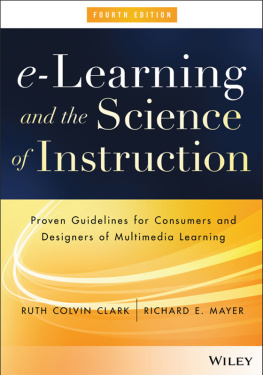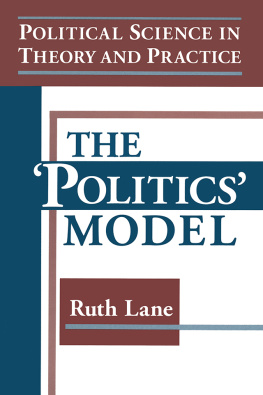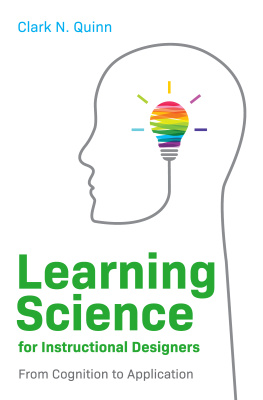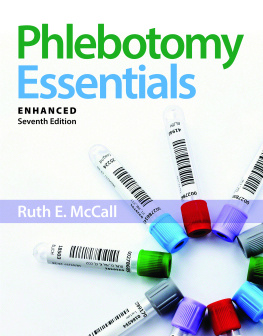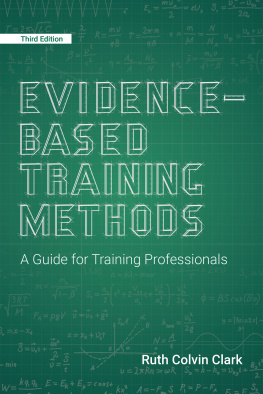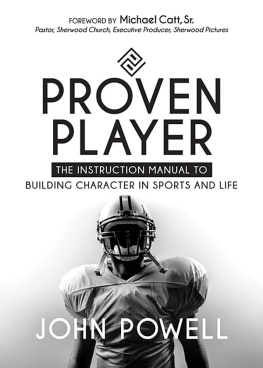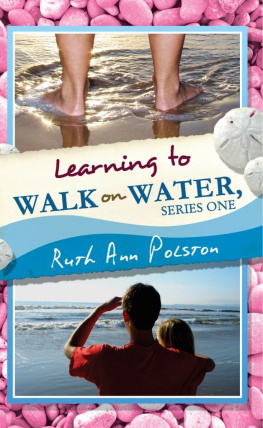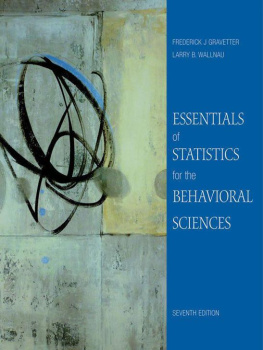Clark Ruth C. - E-Learning and the Science of Instruction: Proven Guidelines for Consumers
Here you can read online Clark Ruth C. - E-Learning and the Science of Instruction: Proven Guidelines for Consumers full text of the book (entire story) in english for free. Download pdf and epub, get meaning, cover and reviews about this ebook. year: 2016, publisher: John Wiley & Sons, Incorporated, genre: Children. Description of the work, (preface) as well as reviews are available. Best literature library LitArk.com created for fans of good reading and offers a wide selection of genres:
Romance novel
Science fiction
Adventure
Detective
Science
History
Home and family
Prose
Art
Politics
Computer
Non-fiction
Religion
Business
Children
Humor
Choose a favorite category and find really read worthwhile books. Enjoy immersion in the world of imagination, feel the emotions of the characters or learn something new for yourself, make an fascinating discovery.
- Book:E-Learning and the Science of Instruction: Proven Guidelines for Consumers
- Author:
- Publisher:John Wiley & Sons, Incorporated
- Genre:
- Year:2016
- Rating:4 / 5
- Favourites:Add to favourites
- Your mark:
- 80
- 1
- 2
- 3
- 4
- 5
E-Learning and the Science of Instruction: Proven Guidelines for Consumers: summary, description and annotation
We offer to read an annotation, description, summary or preface (depends on what the author of the book "E-Learning and the Science of Instruction: Proven Guidelines for Consumers" wrote himself). If you haven't found the necessary information about the book — write in the comments, we will try to find it.
Clark Ruth C.: author's other books
Who wrote E-Learning and the Science of Instruction: Proven Guidelines for Consumers? Find out the surname, the name of the author of the book and a list of all author's works by series.
E-Learning and the Science of Instruction: Proven Guidelines for Consumers — read online for free the complete book (whole text) full work
Below is the text of the book, divided by pages. System saving the place of the last page read, allows you to conveniently read the book "E-Learning and the Science of Instruction: Proven Guidelines for Consumers" online for free, without having to search again every time where you left off. Put a bookmark, and you can go to the page where you finished reading at any time.
Font size:
Interval:
Bookmark:

This is a book about what works in e-learning. Increasingly, organizations are turning to e-learning to save travel costs and instructional time. In fact e-learning in both synchronous and asynchronous formats is on the rise, accounting for nearly 40 percent of all training delivery of workforce learning. However, dollars saved are only an illusion if the quality of the training suffers.
Many books on the market offer useful advice for design and development of e-learning. Unlike these books, the answers we present are not based on opinion and fads; they are based on empirical research. Much of this new research is inaccessible to those producing or evaluating online learning because it has been distributed primarily within the academic research community. This book bridges the gap by summarizing research-based answers to questions that practitioners ask about effective e-learning.
The popularity of the previous editions of this book is testimony to consumer interest in evidence-based guidelines about how to best use visuals, text, audio, practice exercises, and examples in e-learning. In the fourth edition we have updated the previous edition by adding new research, guidelines, and examples. Based on Richard Mayers extensive research on serious games, we have a new chapter on the effects of games on learning. We also have a new chapter on engagement in e-learning that presents recent research on generative multimedia learning.
If you are a designer, developer, evaluator, or consumer of e-learning, you can use the guidelines in this book to ensure that your courseware meets human psychological learning requirements. In particular you can learn evidence-based ways to:
- Communicate your content with words and visuals
- Use audio to describe visuals
- Avoid overloading learners with extraneous media effects
- Optimize social presence in your courseware
- Apply new research on engagement to your e-learning products
- Design examples and practice exercises that build job-relevant skills
- Determine when and how to use networked collaborative activities
- Build thinking skills through evidence-based methods
- Apply recent evidence on serious games to your portfolio of multimedia products
Chapters 1 through 3 lay the foundation for the book by defining e-learning, describing how the methods used in e-learning can promote or defeat learning processes, and summarizing the basic concepts associated with evidence-based practice.
Chapters 4 through 10 summarize the multimedia principles developed over thirty years of research by Richard Mayer and his associates at the University of California. In these chapters you will read the guidelines, the evidence, and the psychology, as well as review examples of how to (1) best use visuals, text, and audio, (2) increase social presence in your lessons, and (3) segment and sequence content in e-learning.
Chapters 11 through 16 focus on evidence-based guidelines related to important instructional methods and approaches in e-learning, including use of examples, practice, and feedback, collaborative learning assignments, navigation tools, and techniques to build thinking skills.
Chapter 17 is new to this edition and summarizes the most recent research on the effects of serious games on learning. In this chapter you will see the evidence that answers three fundamental questions about games: (1) What features promote learning in games? (2) Do games affect basic cognitive aptitudes? and (3) Are games more effective than traditional instructional approaches?
Chapter 18 integrates all of the books guidelines into a comprehensive checklist and illustrates how they apply in concert to asynchronous and synchronous e-learning examples.
The books introduction gives you a summary of specific topics in each chapter.
and the Science of InstructionFourth Edition
Ruth Colvin Clark Richard E. Mayer

Cover image: iconeer/Getty Images, Inc.
Cover design: Wiley
This book is printed on acid-free paper.
Copyright 2016 by Ruth Colvin Clark and Richard E. Mayer. All rights reserved
Published by John Wiley & Sons, Inc., Hoboken, New Jersey
Published simultaneously in Canada
No part of this publication may be reproduced, stored in a retrieval system, or transmitted in any form or by any means, electronic, mechanical, photocopying, recording, scanning, or otherwise, except as permitted under Section 107 or 108 of the 1976 United States Copyright Act, without either the prior written permission of the Publisher, or authorization through payment of the appropriate per-copy fee to the Copyright Clearance Center, 222 Rosewood Drive, Danvers, MA 01923, (978) 750-8400, fax (978) 646-8600, or on the web at www.copyright.com. Requests to the Publisher for permission should be addressed to the Permissions Department, John Wiley & Sons, Inc., 111 River Street, Hoboken, NJ 07030, (201) 748-6011, fax (201) 748-6008, or online at www.wiley.com/go/permissions.
Limit of Liability/Disclaimer of Warranty: While the publisher and author have used their best efforts in preparing this book, they make no representations or warranties with the respect to the accuracy or completeness of the contents of this book and specifically disclaim any implied warranties of merchantability or fitness for a particular purpose. No warranty may be created or extended by sales representatives or written sales materials. The advice and strategies contained herein may not be suitable for your situation. You should consult with a professional where appropriate. Neither the publisher nor the author shall be liable for damages arising herefrom.
For general information about our other products and services, please contact our Customer Care Department within the United States at (800) 762-2974, outside the United States at (317) 572-3993 or fax (317) 572-4002.
Wiley publishes in a variety of print and electronic formats and by print-on-demand. Some material included with standard print versions of this book may not be included in e-books or in print-on-demand. If this book refers to media such as a CD or DVD that is not included in the version you purchased, you may download this material at http://booksupport.wiley.com. For more information about Wiley products, visit www.wiley.com.
Library of Congress Cataloging-in-Publication Data:
Names: Clark, Ruth Colvin, author. | Mayer, Richard E., 1947- author.
Title: E-learning and the science of instruction : proven guidelines for
consumers and designers of multimedia learning / Ruth C. Clark, Richard E. Mayer.
Description: Fourth edition. | Hoboken : Wiley, 2016. | Revised edition of
the authors' E-learning and the science of instruction, 2011. | Includes
bibliographical references and index.
Identifiers: LCCN 2015037550 (print) | LCCN 2015045401 (ebook) | ISBN
9781119158660 (hardback) | ISBN 9781119158677 (pdf) | ISBN 9781119158684
(epub)
Subjects: LCSH: Business educationComputer-assisted instruction. | BISAC:
BUSINESS & ECONOMICS / Human Resources & Personnel Management.
Font size:
Interval:
Bookmark:
Similar books «E-Learning and the Science of Instruction: Proven Guidelines for Consumers»
Look at similar books to E-Learning and the Science of Instruction: Proven Guidelines for Consumers. We have selected literature similar in name and meaning in the hope of providing readers with more options to find new, interesting, not yet read works.
Discussion, reviews of the book E-Learning and the Science of Instruction: Proven Guidelines for Consumers and just readers' own opinions. Leave your comments, write what you think about the work, its meaning or the main characters. Specify what exactly you liked and what you didn't like, and why you think so.

